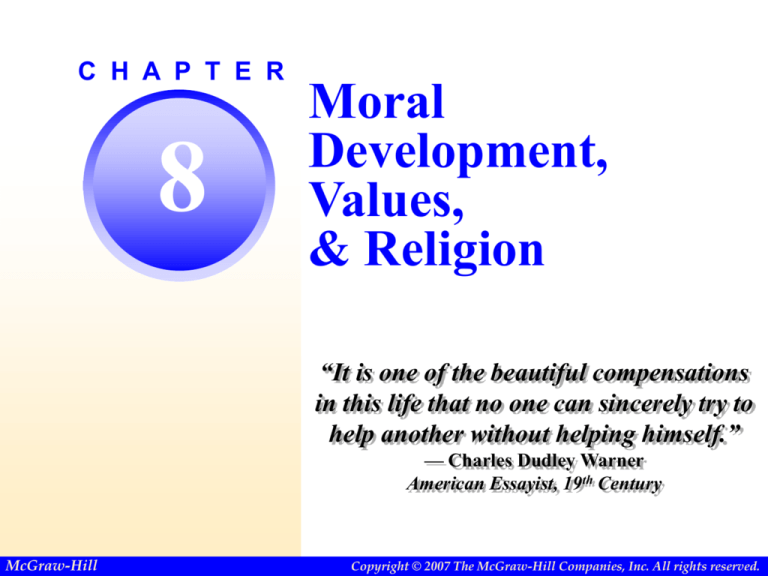
C H A P T E R
8
Moral
Development,
Values,
& Religion
“It is one of the beautiful compensations
in this life that no one can sincerely try to
help another without helping himself.”
— Charles Dudley Warner
American Essayist, 19th Century
McGraw-Hill
Copyright © The McGraw-Hill Companies,Copyright
Inc. Permission
for reproduction
or display.
© 2007required
The McGraw-Hill
Companies,
Inc. All rights reserved.
2
Moral Development
•
Moral development involves
thoughts, feelings, and behaviors
regarding standards of right and
wrong.
1. How do adolescents reason or think
about rules for ethical conduct?
2. How do adolescents actually behave
in moral circumstances?
3. How do adolescents feel about moral
matters?
McGraw-Hill
Copyright © 2007 The McGraw-Hill Companies, Inc. All rights reserved.
3
Moral Thought
• Piaget
– Heteronomous Morality
– Autonomous Morality
– Immanent Justice
McGraw-Hill
Copyright © 2007 The McGraw-Hill Companies, Inc. All rights reserved.
4
Moral Thought
• Piagetian
– Cognitive disequilibrium theory
– Adolescents recognize that their set of
beliefs is one of many.
McGraw-Hill
Copyright © 2007 The McGraw-Hill Companies, Inc. All rights reserved.
5
Moral Thought
• Kohlberg
– Preconventional Reasoning
• Heteronomous morality
• Individualism, instrumental purpose, and
exchange
McGraw-Hill
Copyright © 2007 The McGraw-Hill Companies, Inc. All rights reserved.
6
Moral Thought
• Kohlberg
– Conventional Reasoning
• Mutual interpersonal expectations,
relationships, interpersonal conformity
• Social systems morality
McGraw-Hill
Copyright © 2007 The McGraw-Hill Companies, Inc. All rights reserved.
7
Moral Thought
• Kohlberg
– Postconventional Reasoning
• Social contract or utility and individual
rights
• Universal ethical principles
McGraw-Hill
Copyright © 2007 The McGraw-Hill Companies, Inc. All rights reserved.
8
Moral Thought
• Influences on the Kohlberg Stages
– Modeling
– Peer Relations
• Why Is Kohlberg’s Theory Important?
McGraw-Hill
Copyright © 2007 The McGraw-Hill Companies, Inc. All rights reserved.
9
Moral Thought
• Kohlberg’s Critics
– Moral Thought & Moral Behavior
– Assessment of Moral Reasoning
– Culture & Moral Development
– Gender & the Care Perspective
McGraw-Hill
Copyright © 2007 The McGraw-Hill Companies, Inc. All rights reserved.
10
Moral Thought
Actual Moral Dilemmas Generated by Adolescents
Fig. 8.4
McGraw-Hill
Copyright © 2007 The McGraw-Hill Companies, Inc. All rights reserved.
11
Moral Thought
• Social-conventional reasoning
focuses on thoughts about social
consensus and convention.
• Moral reasoning emphasizes ethical
issues.
McGraw-Hill
Copyright © 2007 The McGraw-Hill Companies, Inc. All rights reserved.
12
Moral Behavior
• Basic Processes
– Reinforcement
– Punishment
– Imitation
McGraw-Hill
Copyright © 2007 The McGraw-Hill Companies, Inc. All rights reserved.
13
Moral Behavior
• Social Cognitive Theory
– Moral competence: The ability to
produce moral behaviors.
– Moral performance: Performing those
behaviors in specific situations.
McGraw-Hill
Copyright © 2007 The McGraw-Hill Companies, Inc. All rights reserved.
14
Moral Behavior
• Prosocial Behavior
– Altruism: Unselfish interest in helping
another person.
– Forgiveness: Occurs when an injured
person releases the injurer from
possible retaliation.
McGraw-Hill
Copyright © 2007 The McGraw-Hill Companies, Inc. All rights reserved.
15
Moral Feeling
• Psychoanalytic Theory
– Ego ideal: The component of the
superego that involves standards
approved by the parents.
– Conscience: The component of the
superego that involves behaviors
disapproved by the parents.
McGraw-Hill
Copyright © 2007 The McGraw-Hill Companies, Inc. All rights reserved.
16
Moral Feeling
• Empathy
– Reacting to another’s feelings with an
emotional response that is similar to the
other’s response.
McGraw-Hill
Copyright © 2007 The McGraw-Hill Companies, Inc. All rights reserved.
17
Moral Feeling
• Contemporary perspective
• Personality
• Moral Identity
• Moral Character
• Moral Exemplars
McGraw-Hill
Copyright © 2007 The McGraw-Hill Companies, Inc. All rights reserved.
18
Contexts of Moral Development
• Parenting
– Discipline
• Love Withdrawal
• Power Assertion
• Induction
McGraw-Hill
Copyright © 2007 The McGraw-Hill Companies, Inc. All rights reserved.
19
Parenting Moral Children and
Adolescents
• Parents of moral children and
adolescents:
– Are warm
– Use inductive discipline
– Involve children in family decisions
– Model moral behavior
– Foster an internal sense of morality
McGraw-Hill
Copyright © 2007 The McGraw-Hill Companies, Inc. All rights reserved.
20
Schools
• The Hidden Curriculum
• Character Education
• Values Clarification
• Cognitive Moral Education
• Service Learning
McGraw-Hill
Copyright © 2007 The McGraw-Hill Companies, Inc. All rights reserved.
21
Values, Religion, and Cults
• Values
– Beliefs and attitudes about the way
things should be.
McGraw-Hill
Copyright © 2007 The McGraw-Hill Companies, Inc. All rights reserved.
22
Values
Changing Freshman Life Goals
Fig. 8.5
McGraw-Hill
Copyright © 2007 The McGraw-Hill Companies, Inc. All rights reserved.
23
Religion
• The Positive Role of Religion in
•
Adolescents’ Lives
Developmental Changes
• “Religion enlightens, terrifies, subdues; it
gives faith, inflicts remorse, inspires
resolution, and inflames devotion”
– Henry Newman
McGraw-Hill
Copyright © 2007 The McGraw-Hill Companies, Inc. All rights reserved.
24
Religion
• Fowler’s Theory
– Stage 1: Intuitive-Projective
– Stage 2: Mythical-Literal
– Stage 3: Synthetic-Conventional
– Stage 4: Individuative-Reflective
– Stage 5: Conjunctive
– Stage 6: Universalizing
McGraw-Hill
Copyright © 2007 The McGraw-Hill Companies, Inc. All rights reserved.
25
Religion
• Religious Indoctrination and
Parenting
• Religiousness and Sexuality in
Adolescence
McGraw-Hill
Copyright © 2007 The McGraw-Hill Companies, Inc. All rights reserved.
26
Cults
• What is the difference between a cult
•
•
•
and a church?
Who Joins Them?
Phase of Life
Potential for Abuse
Illustration copyright © 2002 www.arttoday.com. Used with permission.
McGraw-Hill
Copyright © 2007 The McGraw-Hill Companies, Inc. All rights reserved.
27
Taking it to the Net
• For more information on material
covered in this chapter, visit our
Online Learning Center:
http:www.mhhe.com/santrocka11
McGraw-Hill
Copyright © 2007 The McGraw-Hill Companies, Inc. All rights reserved.






